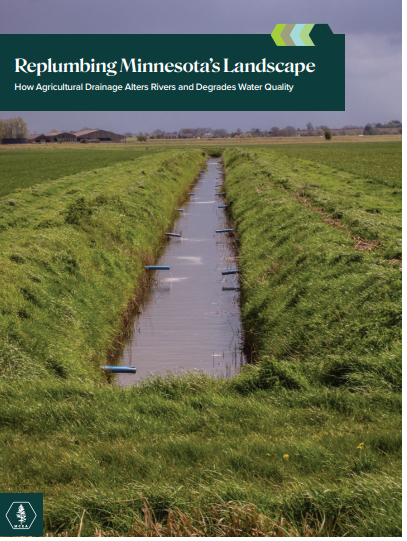New Report: Replumbing Minnesota's Landscape: How Agricultural Drainage Alters Rivers and Degrades Water Quality
Sign up for our emails to stay up-to-date on our work
EXECUTIVE SUMMARY
Replumbing Minnesota’s Landscape:
How Agricultural Drainage Alters Rivers and Degrades Water Quality
The artificial drainage of Minnesota’s agricultural land has increased over the past several decades, with profound costs to the quality of our lakes and streams, fish and aquatic species, recreation, and downstream infrastructure. Beginning around the mid-1970s, corn and soybeans, which require relatively dry soil conditions to thrive, became dominant crops among Minnesota growers.
Because Minnesota was naturally home to many wetlands, prairie potholes, and low-lying saturated areas, farmers needed to drain their fields to achieve dry soil conditions. As a result, many agricultural fields in Minnesota are now underlain by perforated plastic pipes (referred to as “drain tile”), which collect and deliver water to public and private ditches and ultimately to our lakes, rivers, and streams.
These drainage systems negatively impact water quality in two main ways.
First, the increased volume of water delivered from below agricultural fields to our waterbodies causes dramatic physical alterations of watercourses and surrounding infrastructure. This increased volume of water causes riverbanks to erode, sediment to build up in downstream waters, and floods that are more common and severe. Agricultural drainage has nearly doubled the total flow of river systems like the Minnesota River, exacerbating downstream flooding and increasing damage to infrastructure in and along the river.
Second, agricultural drainage harms aquatic life and water quality in downstream waters. Increased erosion results in more turbidity—or amount of suspended sediment—in rivers and streams, which degrades aquatic habitat and can make waters unsuitable to fish or swim in. Nutrients like nitrogen and phosphorus in chemical fertilizer and manure escape the farm through the drainage network, bypassing nature’s filtration systems and polluting many streams, rivers, and lakes. The effects of agricultural drainage on water quality are particularly pronounced in the Minnesota River Basin, where many waters do not meet state standards for maintaining a healthy aquatic ecosystem and supporting aquatic recreation.
The harms to water quality caused by agricultural drainage are exacerbated by the added influence of climate change on our water resources. The changes in water flows over time are not due solely to changes in precipitation patterns caused by climate change. However, the increased likelihood of severe rainfall events due to climate change compounds the negative impacts from agricultural drainage.
The good news is that there are known practices that can help reduce the consequences of agricultural drainage.
We need a combination of best management practices that include changes in land use, changes in nutrient use, and edge of field practices to ultimately make Minnesota’s waters fishable, swimmable, and drinkable again.
Retaining water on fields before it enters lakes and streams is the most effective way to reduce erosion caused by the increased volume of water due to drainage. And there are other practices that help to “treat” drainage water (i.e. allow pollutants to naturally filter out) or slow it down. But despite knowing the consequences of agricultural drainage and the means to mitigate those consequences, the promotion of voluntary practices has not resulted in the widespread adoption needed to make a difference.
We recommend four policy changes that can begin to mitigate the harms to water quality from agricultural drainage.
First, we support efforts to quantify and include the externalized economic costs of drainage projects in the information considered by drainage authorities when evaluating petitions for new or improved public drainage systems.
Second, we recommend a more robust process for considering the environmental effects of drainage projects, which could also aid the state in determining how to meet its nutrient reduction goals.
Third, cap and trade systems have been successfully used to reduce other pollutants in Minnesota and could be used to reduce nitrate and sediment pollution from drainage.
Last, we recommend that the Minnesota Pollution Control Agency (“MPCA”) develop a permitting system for new and improved drainage projects. The water quality issues caused by agricultural drainage are similar to stormwater management problems observed as a result of intensive development in the 1950s, which eventually resulted in the development of a robust and effective stormwater management permit program at the national and state levels. MPCA could implement a similar system to mitigate water quality harms for agricultural drainage projects through a state permit.
Minnesota values its lakes, rivers, and streams. Yet many are impaired to the point that we cannot swim or fish in them or the water is not safe for drinking. MPCA and other state agencies recognize that agricultural drainage is one of our biggest hurdles to improving our waters in intensively-drained watersheds. We need to address this hurdle if we hope to have water that is fishable, swimmable, and drinkable again.
